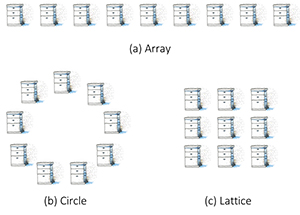
Whether we acknowledge it or not, all beekeepers are farmers who are responsible for keeping domestic animals (our bees) healthy and productive. If you have a couple colonies in your backyard, you may simply enjoy watching your bees and stealing a couple gallons of honey every now and then. If you’re a commercial beekeeper, you’re making your living from keeping your bees healthy and productive.
Of course, one risk of keeping lots of domestic animals close together is the potential for outbreaks of disease. Just think of the large-scale poultry farms and livestock facilities that invest great effort into minimizing disease. Or, if that example doesn’t work for you, think of the kindergarten classrooms where new parents basically expect their children will get sick when they send them off
to school.
So, does the same thing apply to our bees? Should we worry about the density or positioning of colonies in an apiary if we want to maximize “herd health”? This is the topic for our twenty-third “Notes from the Lab,” where we highlight “Industrial bees: The impact of apicultural intensification on local disease prevalence,” written by Lewis Bartlett, Carly Rozins and colleagues and published in the Journal of Applied Ecology [00:1-11 (2019)].
Bartlett, Rozins and colleagues’ study was motivated by two main observations. First, it’s now common knowledge that honey bee colony losses are unsustainably high, and one of the main reasons for high loss rates is disease. Indeed, there’s good evidence that viruses transmitted by varroa, particularly Deformed Wing Virus (DWV), may be the main world-wide driver of honey bee colony losses. Second, we know very little about how diseases are spread between honey bee colonies, and we know even less about how different apicultural practices impact disease risk. That’s a pretty important gap in knowledge given observation #1.
Changing the number or arrangement of colonies in an apiary can potentially influence disease by altering the size of the bee population, frequency of “drifting” between colonies, and network of connections between colonies. To start addressing this question of how different numbers or arrangements of colonies impact risk from disease, the authors created new analytical and agent-based epidemiological models to understand how different factors shape transmission, spread and prevalence. In other words, they used data to predict how the number and arrangement of colonies in an apiary impact disease.
Now, there are probably very few epidemiologists out there who are reading this column. But everyone can understand a major chunk of epidemiology by knowing only one thing: the basic reproduction number of a disease, R0. If R0 is less than 1, prevalence in a population decreases and the disease eventually dies out. This is obviously what epidemiologists love to see, since no one loves disease (aside from a few researchers who study it, but even those researchers were muttering some pretty nasty things about disease during a norovirus outbreak at the recent Ecology and Evolution of Infectious Disease conference in June, where ~40% of attendees became infected! Yes, the irony of a disease outbreak at the Ecology and Evolution of Infectious Disease conference was not lost on its attendees, including some of the authors of this study and the author of this column). Anyways, back to R0. If R0 is greater than 1, the disease spreads and prevalence in a population increases. Such was the case for the norovirus that spread rapidly from one host to infect 40% of the conference attendees.
So, what did they find? Did the arrangement of colonies in an apiary impact R0? Yes. The authors considered three types of arrangements (Fig. 1), and R0 was always greatest for the lattice configuration. This is primarily because the ….


